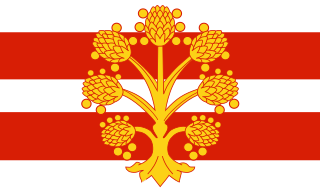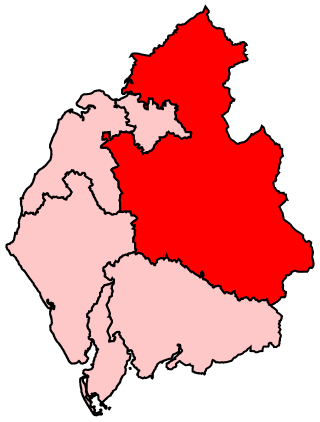
Cumbria is a ceremonial county in North West England, bordering Scotland. It came into existence in 1974 after the passage of the Local Government Act 1972. In April 2023, its county council was abolished and all of its administrative functions were taken over by Westmorland and Furness and Cumberland. Cumbria's largest settlement is Carlisle and other major settlements include Barrow-in-Furness, Kendal, Whitehaven and Workington.

Askham Bryan is a village and civil parish in the unitary authority area of City of York in the north of England, 6 miles (10 km) south-west of York, west of Bishopthorpe, and close to Askham Richard and Copmanthorpe. According to the 2001 census the parish had a population of 582, reducing to 564 at the 2011 census.

Askham Richard is a village and civil parish in the unitary authority of City of York in the north of England, 6.5 miles (10.5 km) south-west of York, close to Copmanthorpe, Bilbrough and Askham Bryan. The population of the civil parish at the 2011 census was 351. The village became a Conservation Area in 1975. Nearby is Askham Bryan College of Agriculture.

Westmorland (, formerly also spelt Westmoreland; is a historic county in North West England spanning the southern Lake District and the northern Dales. It had an administrative function from the 12th century until 1974. Between 1974 and 2023 Westmorland lay within the administrative county of Cumbria. In April 2023, Cumbria County Council was abolished and replaced with two unitary authorities, one of which, Westmorland and Furness, covers all of Westmorland, thereby restoring the Westmorland name to a top-tier administrative entity. The people of Westmorland are known as Westmerians.

Appleby-in-Westmorland is a market town and civil parish in Westmorland and Furness, Cumbria, England, with a population of 3,048 at the 2011 Census. Crossed by the River Eden, Appleby was the county town of the historic county of Westmorland. It was known just as Appleby until 1974–1976, when the council of the successor parish to the borough changed it to retain the name Westmorland, which was abolished as an administrative area under the Local Government Act 1972, before being revived as Westmorland and Furness in 2023. It lies 14 miles (23 km) south-east of Penrith, 32 miles (51 km) south-east of Carlisle, 27 miles (43 km) north-east of Kendal and 45 miles (72 km) west of Darlington.

Eden was a local government district in Cumbria, England, based at Penrith Town Hall in Penrith. It is named after the River Eden, which flows north through the district toward Carlisle. Its population of 49,777 at the 2001 census, increased to 52,564 at the 2011 Census. A 2019 estimate was 53,253. In July 2021 it was announced that, in April 2023, Cumbria would be divided into two unitary authorities. On 1 April 2023, Eden District Council was abolished and its functions transferred to the new authority Westmorland and Furness, which also covers the former districts of Barrow-in-Furness and South Lakeland.

Penrith is a market town and civil parish in Westmorland and Furness, Cumbria, England, about 17 miles (27 km) south of Carlisle. It is less than 3 miles (5 km) outside the Lake District National Park, in between the Rivers Petteril and Eamont and just north of the River Lowther. It had a population of 15,181 at the 2011 census. Despite falling within Westmorland and Furness, it is part of the historic county of Cumberland.

Kirkby Stephen is a market town and civil parish in Westmorland and Furness, Cumbria, England. Historically part of Westmorland, it lies on the A685, surrounded by sparsely populated hill country, about 25 miles (40 km) from the nearest larger towns: Kendal and Penrith. The River Eden rises 6 miles (9.7 km) away in the peat bogs below Hugh Seat and passes the eastern edge of the town. At the 2001 census the parish had a population of 1,832. In 2011, it had a population of 1,522.

Penrith and The Border is a constituency in Cumbria represented in the House of Commons of the UK Parliament since 2019 by Neil Hudson, a Conservative.

Hesket is a large civil parish in the Eden District of Cumbria, England, on the main A6 between Carlisle and Penrith. At the 2001 census it had a population of 2,363, increasing to 2,588 at the 2011 census, and estimated at 2,774 in 2019. The parish formed in 1894 with the passing of the Local Government Act 1894 and was enlarged to incorporate the parish of Plumpton Wall following a County Review Order in 1934. Hesket is part of the historic royal hunting ground of Inglewood Forest. Settlement in the parish dates back to the Roman occupation.

Catterlen is a small village and civil parish 3 miles (4.8 km) north west of Penrith, Cumbria. At the 2001 census the civil parish had a population of 471, increasing to 605 at the 2011 Census.
The University of Cumbria is a public university in Cumbria, with its headquarters in Carlisle and other major campuses in Lancaster, Ambleside, and London. It has roots extending back to the Society for the Encouragement of Fine Arts, established in 1822, and the teacher training college established by Charlotte Mason in the 1890s. It opened its doors in 2007 as a university.
Henry Charles Howard was a British politician.
Askham Bryan College is a specialist land-based college based in Askham Bryan, York, England. It also has centres in Newcastle, Middlesbrough, Saltaire and Wakefield.
The Cumberland and Westmorland Antiquarian and Archaeological Society, founded in 1866, is a local historical, antiquarian, archaeological and text publication society and registered charity covering the modern county of Cumbria.
In the United Kingdom, land based colleges are colleges specialising in agriculture, horticulture, and other topics useful for rural economies. Most land based colleges are members of Landex, which promotes and coordinates the colleges.

Mark Ian Jenkinson is a British Conservative Party politician serving as the Member of Parliament (MP) for Workington since 2019.

Cumberland is a unitary authority area in Cumbria, England. It along with Westmorland and Furness took over one half of the adminstration of Cumbria in April 2023 following the abolition of Cumbria County Council. The council area consists of the areas covered by the former districts of Allerdale, Carlisle and Copeland, which also ceased to function. The authority covers 77% of the area and 90% of the population of the historic county of Cumberland.

Westmorland and Furness is a unitary authority area in northwest England, which came into being on 1 April 2023 on the abolition of Cumbria County Council. The council covers the areas formerly served by the districts of Barrow-in-Furness, Eden and South Lakeland, which also ceased to function. It includes all of the area of the historic county of Westmorland as well as the Furness district of historic Lancashire. It also incorporates a very small part of historic Yorkshire together with about a quarter of the area of the historic county of Cumberland.
















